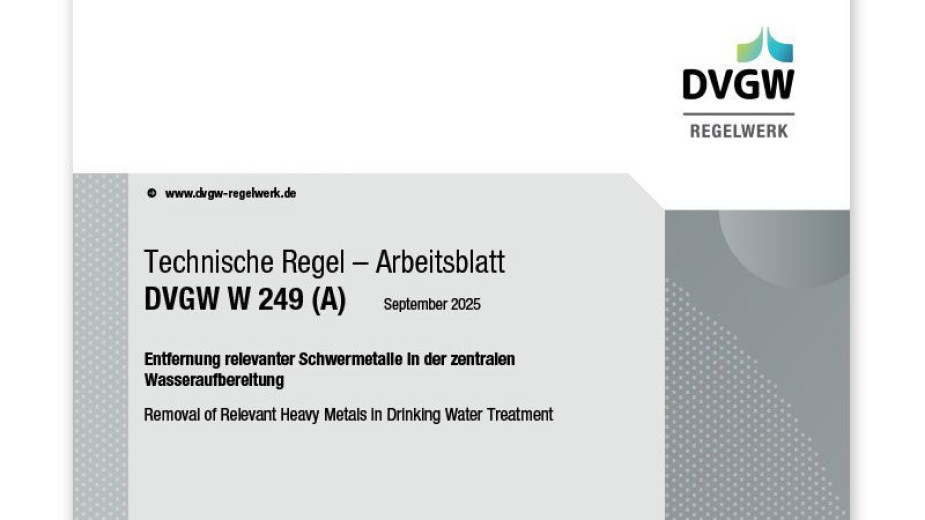DVGW worksheet W 249 supplemented with vanadium and lead

The German Technical and Scientific Association for Gas and Water (DVGW), as the leading technical and scientific association in the gas and water sector, has presented the revised edition of worksheet W 249 (A) ‘Removal of relevant heavy metals in centralised water treatment’, which will be valid from September 2025. The worksheet is part of the comprehensive DVGW regulations, which have been providing technical specifications for a safe and reliable supply for over 165 years and are an indispensable tool for ensuring the highest drinking water quality. It serves as a sound basis for deciding which methods can be used to remove nickel, uranium, vanadium, lead and arsenic from drinking water.
What new features does the current version offer?
The new worksheet replaces the previous version from 2012 (DVGW W 249:2012-07) and takes into account current challenges and scientific findings. One of the most significant changes is the inclusion of vanadium and lead as relevant heavy metals in the context of drinking water treatment. In addition, information on the removal of chromium has been added to the informative appendix, and the new limit values of the Drinking Water Ordinance and the drinking water guidelines have been integrated. The inclusion of the heavy metals lead and vanadium in the regulations has closed an existing knowledge gap, thereby supporting the affected water suppliers in selecting the appropriate treatment process.
Focus on Vanadium and Lead
Vanadium is an ubiquitous trace metal that is classified as carcinogenic in higher concentrations. Although the German Drinking Water Ordinance does not currently specify a specific limit value for vanadium, the German Federal Environment Agency (UBA) has set a toxicologically based guideline value of 4 µg/l with a maximum action value of 20 µg/l. Lead is also toxicologically relevant, can bioaccumulate and, especially in unborn babies, infants and young children, can damage the nervous system and impair blood formation and intellectual development. The German Drinking Water Ordinance stipulates a limit value of 10 µg/l for lead, which will be reduced to 5 µg/l from 2028. In order to compensate for possible increases in concentration in the distribution network and in installations, it is recommended that half of the limit value be complied with at the outlet of the waterworks for both heavy metals in order to avoid negative effects on humans and the environment.
How can the two heavy metals be removed from the water?
The adsorption process using granular ferric hydroxide has proven to be one of the methods of choice for the efficient and targeted removal of the newly added metals, vanadium and lead. Both heavy metals exhibit a high affinity to iron hydroxide surfaces, which enables selective binding to the adsorbent. Fixed-bed adsorption processes offer decisive advantages here: when correctly designed, they enable long operating times combined with high operational reliability and low maintenance requirements. The achievable adsorption capacity depends on the properties of the adsorbent and the specific raw water composition.
DVGW sets standards for the future of water treatment
With the new edition of worksheet W 249, the DVGW reaffirms its commitment to public health and a sustainable drinking water supply. The regulations provide water suppliers and experts with practical and scientifically sound guidelines to ensure compliance with strict quality standards, including those relating to vanadium and lead. This means that, in addition to arsenic removal in water treatment, the reliable removal of lead and vanadium can also be ensured.
The DVGW W 249 (A) worksheet is available on the DVGW website, in the online shop of wvgw Wirtschafts- und Verlagsgesellschaft Gas und Wasser mbH and from DIN Media.
Are you involved in the removal of vanadium and lead from drinking water?
GEH Wasserchemie offers GEH® – granular ferric hydroxide – an established adsorption material that has been used successfully in numerous projects. In addition, we offer GEH plant consulting for the selection and design of suitable processes as well as the GEH performance check for the evaluation of existing systems. This enables solutions to be planned in a practical manner and implemented reliably.
GEH Wasserchemie will be happy to provide you with further information.